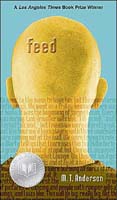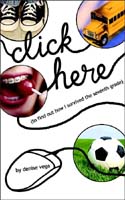| reviews @ tengrrl.com |
|
|
Sunday, May 15, 2005 This young adult novel explores the consequences of a technology out of control, one that ultimately reduces the mental abilities of the humans in this future world. The feed is a technology that is implanted in every baby's head, putting a world of information at every person's mental fingertips. The novel's protagonist, Titus, describes the background and use of the feed:
Anderson's irony is clear here: everyone is "supersmart" now that they can instantaneously look up the "battles of the Civil War George Washington fought in." In truth, these characters have become so dependent upon the feed that their own ability to think and understand the world around them has been lost. Everything is negotiated by the feed. Titus explains further, "the braggest thing about the feed, the thing that made it really big, is that it knows everything you want and hope for, sometimes before you even know what those things are. It can tell you how to get them, and help you make buying decisions that are hard. Everything we think and feel is taken in . . . and they make a special profile, one that's keyed just to you . . . so all you have to do is want something and there's a chance it will be yours" (48). The feed that is presented as a technology that combines the characteristics of computers, television, and radio and that provides just-in-time information keyed to the every experience of the person whose brain it resides in. The examples of the feed in the novel are extreme satire of the media onslaught that shapes life everyday on present-day earth:
Feeds like these provide suggestions throughout the story. At times, characters actively ask the feed for information; at other times, the feed simply suggests based on the character's profile and situation. More frightening than this complete control over the characters' thinking, however, is the close similarities between the feed and the broadcasts any reader might watch or hear on television or radio. Admittedly, my experience with the feed was influenced by the excellent production of the book on tape, which couples the Anderson's words with music, appropriate voice actors, and a smooth transition from the character's thoughts to the feed's suggestions. Anderson's book is an excellent exploration of a science-fiction world that is far too close to our present-day experiences. Couple the book with the taped production for an amazing experience. Details
Saturday, May 14, 2005
Click Here: (To Find Our How I Survived Seventh Grade) by Denise Vega (Little, Brown, 2005)
Thrill in some worst technology metaphors ever: 
Friday, May 13, 2005
More books! Got copies of An Order Of Amelie, Hold The Fries by Nina Schindler, ChaseR : A Novel in E-mails by Michael J. Rosen, and The E-mail Mystery: Nancy Drew Digest #144. Amelie is visually the most interesting—lots of images and text intertwined. The Booklist review said: "Imagine Nick Bantock's Griffin and Sabine series with two young, urban Canadians. Now expand their communication to include e-mails, newspaper clippings, text messages on cell phones, and notes written on toilet paper, hotel registration forms, and take-out menus." It's very different. Very cool. Now if I'd just get finished with Click Here: To Find Out How I Survived Seventh Grade by Denise Vega so that I can read it!
Tags: children's literature | computers in fiction | technology | young adult fiction Wednesday, May 11, 2005
Today began with two new books: an autographed copy of Boy Proof by Cecil Castellucci and a copy of Lauren Myracle's Rhymes with Witches—both from LiteratiCat, my winnings from the contest on teenliterature.
Not exactly children's lit, but I also got a copy of Literacy Moves On: Popular Culture, New Technologies, and Critical Literacy in the Elementary Classroom. Looks like a very promising book. Includes an excellent definition of multimodal literacy—very reader-friendly: Previously a text was seen as being "a passage of print or a slice of speech, or an image" (Lankshear et al. 2002: 45); that is, texts were seen as things written down—books,magazines, and newspapers. They are now perceived as being much more than this. A text is now seen as a unit of communication that may take the form of something written down but also a chunk of discourse, for example speech, a conversation, a radio program a TV advert, text messaging, a photo in a newspaper, and so on. Many of these texts are drawn from children's popular culture and have changed the ways in which young readers expect to read, the ways they think, and the ways they construct meaning. (p. 8)And thanks to Mike on Kairosnews, I found out about what looks like an short chapter book from 1958 that focuses on computers, Danny Dunn and the Homework Machine. Illustrations are listed as by Ezra Jack Keats. I found a used copy online, and it's on its way! Tags: children's literature | computers in fiction | technological literacy | technology | young adult fiction Tuesday, May 10, 2005I'm currently reading
Click Here: To Find Out How I Survived Seventh Grade by Denise Vega. I need to do a little research on Ms. Vega before I review the book because it has some questionably odd imagery. It's a fairly normal tale of young adult social woes of friendship and love, but some of the computerish references are flat-out odd.
Tags: children's literature |
computers in fiction |
technological literacy |
technology | young adult fiction
I need to return to Feed, which I read months ago, and write up a review for it. And I need to decide whether to review non-computerish books here as well. But not tonight. Today's kind delivery included The Secret Blog of Raisin Rodriguez by Judy Goldschmidt and The Dating Game #1 by Natalie Standiford (according to Booklist, it's about the "Dating Game Web site, which [the characters] created for their Interpersonal Human Dynamics class." My pile of things to read grows and grows! |
archives March 2005 April 2005 May 2005 June 2005 November 2005   amusements
education
news
people
places
technoise
techrhet
YA lit authors
|
||||||
|
|
|||||||